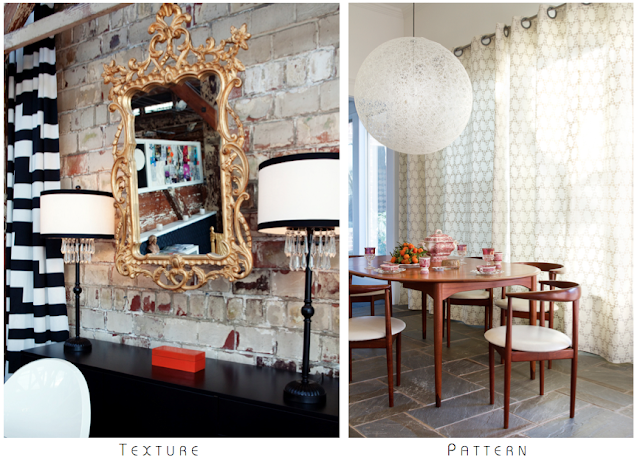I have no pretension when it comes to my education in interior design. Though a formal education in the subject truly ups your knowledge, I believe that the ability to design your home in a way that is fitting to you can be acquired through your own learning, studying and practice. Yes, I am aware this thought could potentially put me out of a job, but so be it.
I suppose that in order to help those who find this way of thinking to be all too kind and somewhat naive, I should teach you the basics I learned in ID 104 - no tuition necessary. May I present to you: the Principles and Elements of Design.
I suppose that in order to help those who find this way of thinking to be all too kind and somewhat naive, I should teach you the basics I learned in ID 104 - no tuition necessary. May I present to you: the Principles and Elements of Design.
Principles
Balance, Harmony, Rhythm, Dominance, Variety, Proportion
In design, balance creates a feeling of equality. It is achieved through the proper use visual weight (of colors, patterns, shapes, and textures) and measurable weight (positioning, size, and mass)
Harmony is created when the separate elements in the room dance together to form a unified picture.
The rhythm of a room is similar to that of music - it has some repetition, some emotional value, it provides the illusion of movement, and provides a "beat" to the design. Think in musical terms - is it legato, staccato, forte, pianissimo?
Dominance is created with contrast, size, placement and line direction. Feature that which is most important as the dominant feature, be it a view in the living room, a bed in the bedroom, a color in the kitchen, etc. Each room needs something to be the foundation for all of the accessories to grasp onto.
Variety in the Elements of design creates visual interest. Remember, Variety + Harmony = Unity.
Proportion refers to the relative size and its physical relationship to other objects. Playing with proportion can completely change the room - compare the grand and proper feelings within a cathedral to the comfort of a treehouse. Playing with proportion, be in in a pattern on a fabric, a piece of furniture or the architecture of your home, can result in a sassy attempt at adding personality.
There you have it, the Principles of Design. Next up, Elements
Elements
Form, Scale, Texture, Pattern, Color, Light
The form is the basic configuration of an object and is typically 3-D. The four characteristics of form are line, shape, planes and volume.
Scale is similar to proportion, but it considers each individual element one to another before the whole proportion is taken into account.
There are two types of texture, 1. Tactile - something that can actually be felt (velvet), and 2. Visual - something like a small pattern on a fabric that gives the allusion of depth.
Patterns are repeated elements within the appearance of the room. Was that obvious enough?
Color has the most control over the feel of the space. Keep in mind that nearly every emotion can be felt through color so choose wisely.
A mix of natural and artificial lighting is preferred in every space, but that is not always possible. Lighting can be used both practically and as a way to add emphasis and helps create the feeling you are going for.
Here is a helpful hint to remember the difference between the Principles and the Elements. The Principles of design are the laws that will create what our eye considers to be the best design possible. The Elements, however, are the things that will help those rules come to life - they are the single ingredients that, when molded and prodded, will assist in creating the Principles.
What is so great about having a knowledge of the Principles and Elements of design is that once learned, they can be applied to any blank room and put into practice. Much like an artist needs paint in order to begin his masterpiece or a violinist rosin on his bow, a person needs an understanding of the principles and elements of design before a room can be completed. And remember, once you learn and accept the rules, you are then qualified to stylistically break them.







superbbbbbbbbbbbbbbb
ReplyDelete